|
Week 3: August 15-21, 2010 |
Welcome
to the McGill Bird Observatory weekly report.
Click here for a complete listing of our archives.
Comments or
questions are welcome at "mbo AT migrationresearch.org".
|
PICTURE
OF THE WEEK: |
|
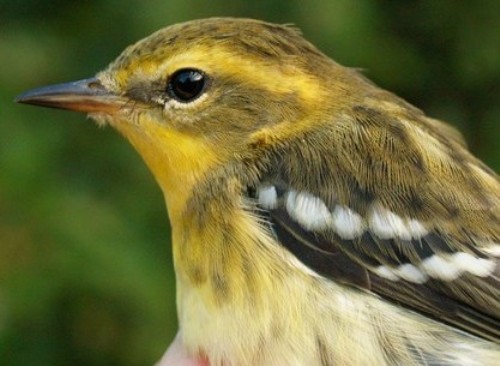
One of four Blackburnian Warblers banded at MBO this week. This species has only
been banded here in two of five previous fall seasons, and only once before have we had
more than one individual in an entire season, so this week's movement was significant.
(Photo by Simon Duval)

|
MBO
gratefully acknowledges the fundraising efforts of CCFA (Centre de Conservation de la Faune Ailée) in support of MBO - drop in at the store or click on the logo at left to visit the website for details on bird posters for sale with proceeds benefiting MBO.
|
|
|
|
THIS WEEK |
THIS FALL |
2010 TOTAL |
SITE TOTAL |
|
# birds (and species) banded |
250 (38) |
692 (48) |
1567 (68) |
25076 (105) |
|
# birds (and species) repeat |
28 (14) |
102 (23) |
316 (38) |
4657 (66) |
|
# birds (and species) return |
3 (3) |
11 (9) |
143 (29) |
763 (37) |
|
# species observed |
72 |
92 |
148 |
202 |
|
# net hours |
508.5 |
1534.5 |
5093.9 |
45001.1 |
|
# birds banded / 100 net hours |
49.2 |
45.1 |
30.8 |
55.7 |
|
|
Note: table does not include nocturnal banding (owls) |
|
Bander-in-charge: Simon Duval
Assistants: Steve Charlton, Jane Cormack, Jean Demers, Leah Den Besten, Le Duing Lang, Nicki Fleming, Marie-Anne Hudson, Marie-France Julien, Chris Murphy, Clémence Soulard, Patricia Stotland, Rodger Titman, Sylvia Wees
Notes: It was another great week at MBO, with an unprecedented (for this time of year) flood of warblers keeping things busy most days. The highlight may have been Tuesday, when 35 individuals of 13 warbler species were banded, including 3 Canada and 2 Blackburnian Warblers. By the end of the week, we had banded 178 warblers of 17 species - particularly impressive given that the average total for week 3 across all species is 146 individuals. Overall, we reached a total of 250 birds banded this week, exactly the same number as in week 1, and also like in the first week, that set a new record, this time much greater than last year's high count of 184. The season total of 691 also remains far ahead of the previous record of 560 at this point, but it's worth noting that the mostly great weather so far has allowed us to operate a record number of net hours, and so the capture rate for the season to date is only slightly ahead of the previous record of 43.6 from 2006. Meanwhile the counts of species observed for the week and for the season continue to lag well below average - perhaps in part because we are relatively short on observers this month and the high level of activity in the nets is limiting opportunities for other observations.
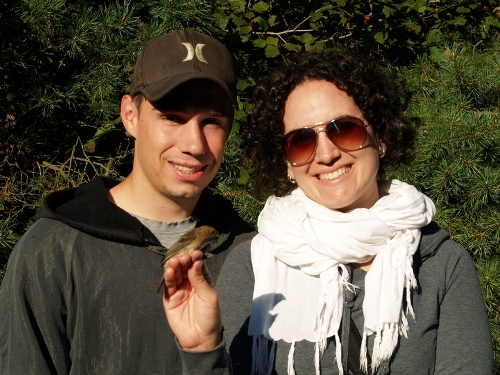
Above, Simon and Marie-Anne posing on Friday morning with a very special Indigo Bunting, which happened to become the 25,000th bird banded at MBO.
(Photo by André Boulianne)
Below, one of the record number of American Redstarts we banded this week, a striking after-hatch-year male.
(Photo by Simon Duval)
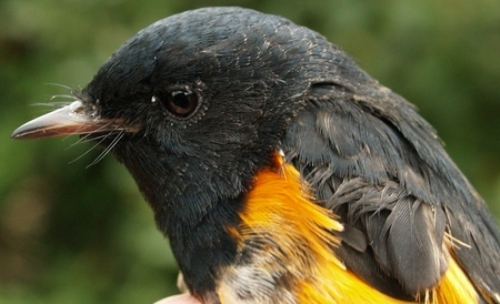
|
Again this week we received some interesting news from the banding office about a recovery. This time it regards the foreign-banded Northern Waterthrush we captured back in May. We now have learned that it was banded at the Powdermill Nature Reserve in Pennsylvania as a second-year bird in May 2003, making the bird 8 years old, and within one year of setting a new longevity record for the species.
We also had another interesting recovery of our own this week, courtesy of a Nashville Warbler we banded as an after-hatch-year male on August 3, 2007, recaptured almost exactly 13 months later on September 2, 2008, and now back at MBO again as of August 20. This individual seems to be returning to MBO repeatedly to undergo its annual prebasic molt; while molt migration is becoming recognized as a fairly common phenomenon among western North American species, it appears to be much less common in the east, with Nashville and Tennessee Warblers and Swainson's Thrushes among the few species for which we are building up a fair amount of evidence at MBO.
|
This week’s top 10
[last year's rank for this week in brackets]
|
# individuals banded |
mean # individuals observed daily |
|
1. American Redstart (41) [2] |
1. American Crow (24.3)
[1] |
|
2. Magnolia Warbler (37) [-] |
2. Common Grackle (24.0) [6] |
|
3. Song Sparrow (27)
[1] |
3. Black-capped Chickadee (17.9)
[2] |
|
4. Canada Warbler (16)
[-] |
4. American Goldfinch (12.6)
[4] |
|
5. Chestnut-sided Warbler (13) [-] |
5. Cedar Waxwing (11.6)
[5] |
|
6. Black-and-white Warbler (12) [-] |
6. American Redstart (11.0) [-] |
|
6. Common Yellowthroat (12)
[2] |
7. Song Sparrow (9.7)
[3] |
|
6. Indigo Bunting (12) [6] |
8. American Robin (7.4) [7] |
|
9. Tennessee Warbler (11)
[8] |
8. Blue Jay (7.4) [-] |
|
10. Ovenbird (8) [9] |
10. Magnolia Warbler (7.0)
[-] |
|
For the first time this fall, Song Sparrow isn't on top of the list of birds banded. Instead, American Redstart is in first place for week 3, for the third time in the past four years. The number of individuals, however, is particularly impressive - our previous single-week record was 22 individuals, and so far this fall, 77 American Redstarts have been banded at MBO, already 30 more than at this point in any previous season. As noted regarding Common Yellowthroats last week, it would seem they are either particularly abundant this year, or migrating earlier than usual, as the peak for redstarts is on average not until week 5. A third species showing up in impressive numbers earlier than usual is Magnolia Warbler. It too typically peaks in week 5, and in previous years a maximum of 12 individuals was banded in week 3, so the count of 37 this week was very surprising. The strong movement of warblers was also reflected by Canada Warbler and Chestnut-sided Warbler, both of which set new records for numbers banded in a single week. In fact, we banded more Canada Warblers this week than in four of five previous entire fall seasons! The eight warbler species in the top ten matches this week in 2008, which turned out to be a great warbler year right through to mid-October ... we can only hope that these early signs are an indication we'll have that kind of luck again in 2010.
The list of species observed didn't change as drastically from last week, although it's noteworthy that American Redstart and Magnolia Warbler were both abundant enough to crack the top ten, both for the first time so early in fall. The mean daily count of 11 American Redstarts is actually the highest we've ever recorded in any week. American Crow topped the list in three of the previous five years, so it's not surprising to see them out in front again. American Goldfinch at this time of year is awfully consistent, ranking between second and fourth in all six years, although the mean daily count has ranged from 13 to 24.
|
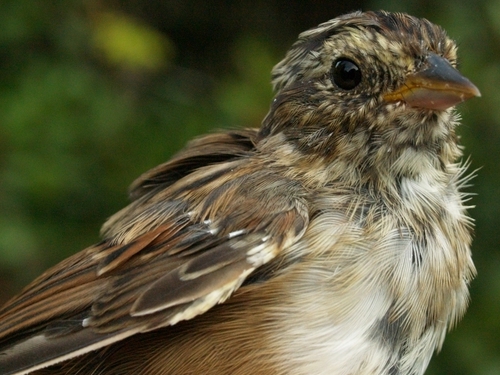
In 2006, we began to notice that some hatch-year Song Sparrows at MBO were replacing their primaries and primary coverts, contrary to what is suggested about their molt in the literature. Over the course of a couple of years, we realized this was fairly common, and we published a paper on the subject in North American Bird Bander (33: 1-6) and provided supplementary information on our website. We suspected that a similar molt might occur in the closely related Swamp Sparrow, but we band them in far smaller numbers. However, this week we had not one but two hatch-year Swamp Sparrows that were replacing primaries, as visible in the photos above and below.
(Photo by
Simon Duval)
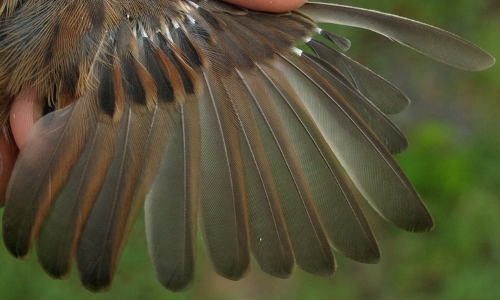
|






